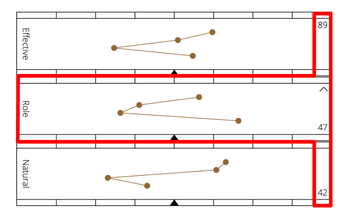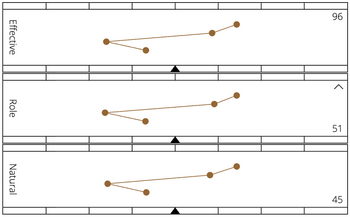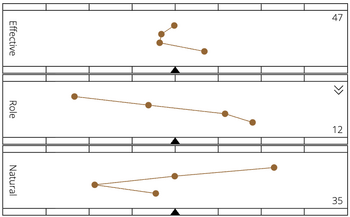Adaptation: Difference between revisions
mNo edit summary |
|||
| Line 1: | Line 1: | ||
=Introduction= | =Introduction= | ||
How a person adapts and is engaged is important information measured by the adaptive profile. This information has profound implications for understanding a person’s efficacy and performance, with remedies that can be found in the person’s Natural profile, how they connect with others, their job, and the environment. | |||
=Generalities= | =Generalities= | ||
The | [[File:Profile Role in Red.png|right|350px]] | ||
The Role profile—the profile in the middle of the adaptive profile, circled in red on the right—measures how people more or less adapt to the environment in a way that’s engaging or not. The more different the Role profile is from the Natural, the greater the perceived need for adaptation. Consequently, the Effective behavior—the profile on top, the behaviors people most probably see—will be different. The arrows and numbers on the right indicate how the person feels engaged or disengaged in their environment. Those various aspects are discussed below. | |||
With symbolic interactionism | =Conceptualization= | ||
The conceptualization of the Role concurs with the dynamic model of personality elaborated by Mischel and Shoda<ref>Mischel, W., Shoda Y. (1995). A Cognitive-Affective System Theory of Personality : Reconceptualizing Situations, Dispositions, Dynamics, and Invariance in Personality Structure. Vol. 102, No. 2, p. 248-268.<br/>Mischel, W., Shoda Y., Ayduc, O. (2008). Introduction to Personality. Toward an Integrative Science of the Person. John Wiley & Sons.</ref> Adaptation can also be approached by the observations of organizations<ref>Likert, R. (1967). The Human Organisation. Its management and value. New York: McGraw Hill.</ref> and society<ref>Riesman, D., Glazer, N., Denney, R. (1950). The Lonely Crowd: A study of the changing of American Character. New Haven: Yale University Press.</ref>. In sociology, the Role is analyzed by symbolic interactionism and functional perspectives. | |||
* With symbolic interactionism<ref>Mead, G. H. (1934). From the standpoint of a behaviorist. University of Chicago Press.</ref>, the individual interacts with the environment through their cognitive, affective, and symbolic faculties. They adapt their natural behaviors to the environment as they perceive it. | |||
* From the functionalist perspective, a person's social role influences their mode of action. What is expected of the person and how they integrate it determines their social behavior<ref>Parsons T. (1951). The Social System. New York: The Free Press.</ref>. The Role graph measures the behavior that the person perceives to act out. This behavior may differ from what is expected by the environment. | |||
The perceived adaptation showing in the Role profile can be circumstantial, reflecting temporary efforts, or structural when the required efforts are prolonged. Adaptation results from the environment's or a person's insistence on adapting behaviors over time. The following aspects of the adaptation are further described below: | |||
* Flow and personal efficacy when the three graphs have shapes close to each other, | |||
The perceived adaptation | * Adaptation when the shapes of the Natural and Role are different, and | ||
* Engagement and disengagement, where the arrows to the right of the Role point up or down. | |||
* | |||
* | |||
* | |||
=Personal Efficacy= | =Personal Efficacy= | ||
In the examples below | In the examples below, the three graphs are aligned. The perceived role is in phase with the natural behaviors. Consequently, the behaviors of the Effective are aligned too. In these situations, the person adopts behaviors that are in sync with their natural way of behaving; the person is in flow.<ref>Csikszentmihalyi, Mihaly (1990). Flow: The Psychology of Optimal Experience. Harper Perennial Modern Classics</ref>. | ||
</ref>. | |||
[[File:Adpatation Same.png|center|350px]] | [[File:Adpatation Same.png|center|350px]] | ||
<center>Profile Corresponding to Personal Effectiveness.</center> | <center>Profile Corresponding to Personal Effectiveness.</center> | ||
The concept of adaptation, as it is evidenced in the Role profile, concurs with the observations of self-efficacy. Self-efficacy refers to | The concept of adaptation, as it is evidenced in the Role profile, concurs with the observations of self-efficacy. Self-efficacy refers to a person mastering and controlling their environment and also mastering their belief about their own skills. Self-efficacy, which is considered a stable disposition and highly resistant to change is associated with more job satisfaction through its impact on self-evaluation, less burnout and higher performance. | ||
=Adaptation= | =Adaptation= | ||
The more different the shapes of the Natural and Role profiles, the greater the pressure from the person or the | The more different the shapes of the Natural and Role profiles are, the greater the pressure from the person or from the environment to adapt. Significant discrepancies between the Natural and the Role come along with what has been described in the literature as emotional fatigue, a feeling of depersonalization, and less accomplishment, abusive, aggressive behaviors or psychological pressures of depression, coming for some with a lack of sleep and gastric problems. | ||
A wide profile with an inverted Role, as in | A wide profile with an inverted Role, as in the figure below, creates frustration and burnout and will cause the person to disengage or leave the position. These situations come with a reduction in self-confidence, well-being, and productivity. | ||
[[File:Adaptation Different.png|center|350px]] | [[File:Adaptation Different.png|center|350px]] | ||
| Line 35: | Line 33: | ||
=Engagement and Disengagement= | =Engagement and Disengagement= | ||
A difference in response levels | A difference in response levels indicated by the three numbers on the right of the profiles) between the Natural and the Role reflects whether the environment stimulates the person, and they consequently feel engaged (arrows pointing up) or the opposite, disengaged (arrows pointing down). This measure comes from the different responses given to the two questions of the GRI survey about the environment and oneself. | ||
The arrows pointing up indicate stimulation, engagement, involvement, and commitment. Conversely, the arrows pointing down indicate demotivation, disengagement, and lack of productivity. | The arrows pointing up indicate stimulation, engagement, involvement, and commitment. Conversely, the arrows pointing down indicate demotivation, disengagement, and lack of productivity. The figure below shows examples of very low and very high engagement. | ||
<center>[[File:Adaptation Disengaged.png|350px]] [[File:Adaptation Engaged.png|350px]]</center> | <center>[[File:Adaptation Disengaged.png|350px]] [[File:Adaptation Engaged.png|350px]]</center> | ||
<center>Very Low Engagement (left) | <center>Profile showing a Very Low Engagement (left) or a Very High Engagement (right).</center> | ||
When a single arrow points down, this reflects low engagement. With two arrows, it reflects high dissatisfaction | This dimension of engagement can be approached by the opposite of Self-efficacy or negative affectivity when the engagement is low and is combined with little adaptation. | ||
When a single arrow points down, this reflects the person’s low engagement. With two arrows, it reflects high dissatisfaction, frustration, or an intention to leave work. They may be associated with a lack of environmental support. | |||
=Notes= | =Notes= | ||
Revision as of 05:17, 21 September 2025
Introduction
How a person adapts and is engaged is important information measured by the adaptive profile. This information has profound implications for understanding a person’s efficacy and performance, with remedies that can be found in the person’s Natural profile, how they connect with others, their job, and the environment.
Generalities
The Role profile—the profile in the middle of the adaptive profile, circled in red on the right—measures how people more or less adapt to the environment in a way that’s engaging or not. The more different the Role profile is from the Natural, the greater the perceived need for adaptation. Consequently, the Effective behavior—the profile on top, the behaviors people most probably see—will be different. The arrows and numbers on the right indicate how the person feels engaged or disengaged in their environment. Those various aspects are discussed below.
Conceptualization
The conceptualization of the Role concurs with the dynamic model of personality elaborated by Mischel and Shoda[1] Adaptation can also be approached by the observations of organizations[2] and society[3]. In sociology, the Role is analyzed by symbolic interactionism and functional perspectives.
- With symbolic interactionism[4], the individual interacts with the environment through their cognitive, affective, and symbolic faculties. They adapt their natural behaviors to the environment as they perceive it.
- From the functionalist perspective, a person's social role influences their mode of action. What is expected of the person and how they integrate it determines their social behavior[5]. The Role graph measures the behavior that the person perceives to act out. This behavior may differ from what is expected by the environment.
The perceived adaptation showing in the Role profile can be circumstantial, reflecting temporary efforts, or structural when the required efforts are prolonged. Adaptation results from the environment's or a person's insistence on adapting behaviors over time. The following aspects of the adaptation are further described below:
- Flow and personal efficacy when the three graphs have shapes close to each other,
- Adaptation when the shapes of the Natural and Role are different, and
- Engagement and disengagement, where the arrows to the right of the Role point up or down.
Personal Efficacy
In the examples below, the three graphs are aligned. The perceived role is in phase with the natural behaviors. Consequently, the behaviors of the Effective are aligned too. In these situations, the person adopts behaviors that are in sync with their natural way of behaving; the person is in flow.[6].
The concept of adaptation, as it is evidenced in the Role profile, concurs with the observations of self-efficacy. Self-efficacy refers to a person mastering and controlling their environment and also mastering their belief about their own skills. Self-efficacy, which is considered a stable disposition and highly resistant to change is associated with more job satisfaction through its impact on self-evaluation, less burnout and higher performance.
Adaptation
The more different the shapes of the Natural and Role profiles are, the greater the pressure from the person or from the environment to adapt. Significant discrepancies between the Natural and the Role come along with what has been described in the literature as emotional fatigue, a feeling of depersonalization, and less accomplishment, abusive, aggressive behaviors or psychological pressures of depression, coming for some with a lack of sleep and gastric problems.
A wide profile with an inverted Role, as in the figure below, creates frustration and burnout and will cause the person to disengage or leave the position. These situations come with a reduction in self-confidence, well-being, and productivity.
Engagement and Disengagement
A difference in response levels indicated by the three numbers on the right of the profiles) between the Natural and the Role reflects whether the environment stimulates the person, and they consequently feel engaged (arrows pointing up) or the opposite, disengaged (arrows pointing down). This measure comes from the different responses given to the two questions of the GRI survey about the environment and oneself.
The arrows pointing up indicate stimulation, engagement, involvement, and commitment. Conversely, the arrows pointing down indicate demotivation, disengagement, and lack of productivity. The figure below shows examples of very low and very high engagement.
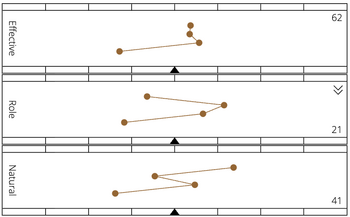
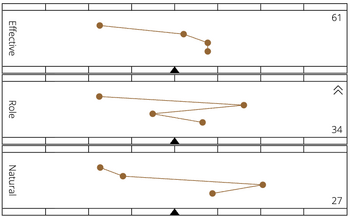
This dimension of engagement can be approached by the opposite of Self-efficacy or negative affectivity when the engagement is low and is combined with little adaptation. When a single arrow points down, this reflects the person’s low engagement. With two arrows, it reflects high dissatisfaction, frustration, or an intention to leave work. They may be associated with a lack of environmental support.
Notes
- ↑ Mischel, W., Shoda Y. (1995). A Cognitive-Affective System Theory of Personality : Reconceptualizing Situations, Dispositions, Dynamics, and Invariance in Personality Structure. Vol. 102, No. 2, p. 248-268.
Mischel, W., Shoda Y., Ayduc, O. (2008). Introduction to Personality. Toward an Integrative Science of the Person. John Wiley & Sons. - ↑ Likert, R. (1967). The Human Organisation. Its management and value. New York: McGraw Hill.
- ↑ Riesman, D., Glazer, N., Denney, R. (1950). The Lonely Crowd: A study of the changing of American Character. New Haven: Yale University Press.
- ↑ Mead, G. H. (1934). From the standpoint of a behaviorist. University of Chicago Press.
- ↑ Parsons T. (1951). The Social System. New York: The Free Press.
- ↑ Csikszentmihalyi, Mihaly (1990). Flow: The Psychology of Optimal Experience. Harper Perennial Modern Classics

